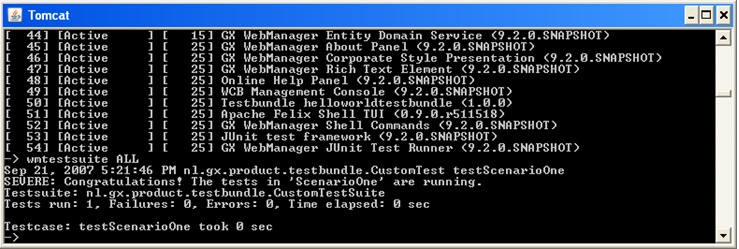...
| Table of Contents | ||
|---|---|---|
|
...
The XperienCentral test framework is based on JUnit. See the JUnit website for an introduction to the framework and documentation (for example on the use of "asserts’). A testbundle is an executable Java application that is used to test other parts of the application. A plugin developer can use this framework to create testbundles for the plugins the developer writes. The big advantage of testbundles is that they are very easily incorporated into the build process. The execution of the tests can be automated, which saves a lot of time testing the plugin’s functions. It also contributes to higher quality of the developed plugins.
...
- Open a command prompt.
- Navigate to the directory in which you already created your helloworld plugins (
C:\GX\helloWorldWCBs,helloWorldfor example). - Enter the command (replace
<XperienCentral Version>with the version number of XperienCentral that you’re building against, (10.10.0, for example):
mvn archetype:generate -DinteractiveMode=false -DarchetypeGroupId=nl.gx.webmanager.archetypes -DarchetypeArtifactId=XperienCentral-testbundle-archetype -DarchetypeVersion=<webmanager version> -DgroupId=com.gxXperienCentral.helloworld -DartifactId=helloworldtestbundle -Dclassprefix=HelloWorld -s ..\XperienCentral9\settings.xml
A new folder called “helloworldtestbundle” is created
...
Building and Deploying the Testbundle
...
- Open a command prompt.
- Navigate to the folder
C:\GX\helloWorldWCBshelloWorld\helloworldtestbundle. - Execute the command:
mvn -s ..\..\XperienCentral\settings.xml clean package - Copy the file
helloworldtestbundle-1.0.0.jarfrom the “target” directory toC:\GX\XperienCentral\work\deploy.
...
Running the Testbundle
The testbundle is now deployed in the XperienCentral release. The easiest way to run the test it is from the Tomcat console. In order to run this test from the console, a few extra bundles need to be present. Therefore, copy the following bundles to C:\GX\XperienCentral9\work\deploy:
...
The result will be the following lines in the Tomcat log:
...
Adding Tests to the Default Testbundle
...
- Run the
setUpmethod. - Run all methods that start with "test" - the order in which they will be processed is not fixed.
- After running the tests, the method
tearDownwill be called.
...
Accessing the XperienCentral API from the Testbundle
...
| Code Block | ||
|---|---|---|
| ||
public class CustomTest extends TestCase {
private static final Logger LOG = Logger.getLogger(CustomTest.class.getName());
private static final String USERNAME = "Administrator";
private static final String PASSWORDCLEANBUILD = "Administrator";
private static final String PASSWORDAFTERLOGIN = "123456";
private static final String WEBID = "26098";
private Session mySession = null;
private ElementManagementService myElementService = null;
private PageManagementService myPageService = null;
private MediaRepositoryManagementService myMediaRepositoryService =null;
protected void setUp() {
initializeServices();
}
protected void tearDown() {
}
public void testScenarioOne() {
// Place your tests in this method
LOG.log(Level.SEVERE, "Congratulations! The tests in 'ScenarioOne' are running.");
}
private void initializeServices() {
// Contents of this method is presented on the next page
}
}
private void initializeServices() {
try {
LOG.log(Level.INFO, "Retrieving SessionManager from Service Framework");
Framework framework = FrameworkFactory.getInstance().getFramework();
SessionManager sessionManager = null;
AuthorizationService authorizationService = null;
ConfigurationManagement configService = null;
try {
sessionManager = (SessionManager)
framework.getService(SessionManager.class.getName());
authorizationService = (AuthorizationService)
framework.getService(AuthorizationService.class.getName());
configService = (ConfigurationManagement)
framework.getService(ConfigurationManagement.class.getName());
} catch (FrameworkException e) {
LOG.log(Level.SEVERE, "Error in retrieving the SessionManager from the framework.", e);
}
String portnr = configService.getParameter("website_settings.frontend_portnr");
String hostname = configService.getParameter("website_settings.backend_hostname");
MockServletContext context = new MockServletContext();
MockHttpServletRequest request = new MockHttpServletRequest(context);
request.addParameter("webid", WEBID);
request.setServerName(hostname);
request.setServerPort(Integer.parseInt(portnr));
MockHttpServletResponse response = new MockHttpServletResponse();
mySession = sessionManager.createSession(request, response);
if(!authorizationService.login(USERNAME, PASSWORDCLEANBUILD, request)) {
LOG.severe("Login failed with username '" + USERNAME + "' and password '" + PASSWORDCLEANBUILD + "'. Another
login attempt is made with password '" + PASSWORDAFTERLOGIN + "'.");
if (!authorizationService.login(USERNAME, PASSWORDAFTERLOGIN, request)) {
LOG.severe("Second login attempt also failed.");
}
}
myElementService = mySession.getElementManagementService();
myPageService = mySession.getPageManagementService();
myMediaRepositoryService = mySession.getMediaRepositoryManagementService();
} catch (ConfigurationManagementException e) {
LOG.severe(e.toString());
e.printStackTrace();
}
} |
...
Using the Spring Mock Framework
XperienCentral integrates the Spring mock classes to make it more convenient to write JUnit testbundles. For example, this can be used to emulate a request and response. More information about Spring mock can be found at junit.org.
